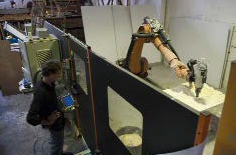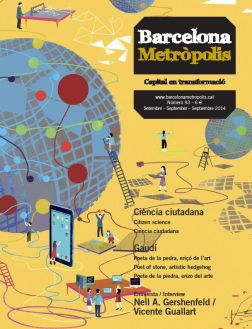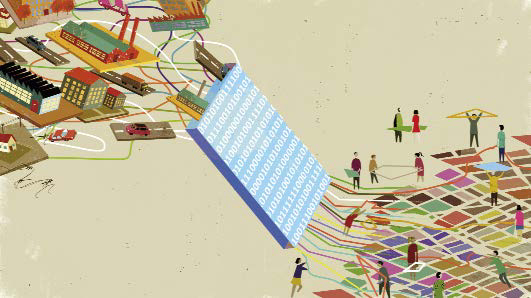The goal of the Fab City project is to develop a fully productive city whose inhabitants share their knowledge to solve local problems and set up new businesses and education schemes. Barcelona already has two ‘manufacturing athenaeums’ which take inspiration from this philosophy.
Today’s financial, environmental, social and political crises are the result of a production model that has been forged over a period of more than a hundred years. This model is based on oil as a source of energy and a raw material, on mass production and on a standardised global economic system. Modern industrialisation feeds on the natural resources of Africa and the Americas, on oil from the Middle East and on cheap labour in Asia.
Today, the technology, resources and administrative organisation of our cities (generally based on models that emerged in very different economic, social political, environmental and technological conditions decades and even centuries ago) are very nearly obsolete, while our current level of consumption is threatening their sustainability for future generations.
The model that shaped the industrial city put production centres right at its heart and absorbed much of the rural population. Later on, manufacturing left the city and moved thousands of miles away, which led to an increase in consumption of fossil fuels, reduced work opportunities and – worst of all – separated consumption operations from production processes. Cities have turned into vast rubbish factories and their survival depends on the technology that is produced far away. They are the physical manifestation of our current consumption-based model.
Cities (which are mankind’s most complex creation, the scene of most of our interactions and where the biggest challenges for the future lie) need technology to work, to provide their inhabitants with conveniences and to meet their needs. But, as well as this, they need to innovate and create their own technology to share with other urban centres; to develop solutions by way of the city and its population.
From arts and crafts to globalisation
In medieval cities, most manufacturing took place within the city walls. The purpose of craftsmanship was to meet local demands and needs, and only after they were met was there any connection with other settlements. After that, industrialisation drove a rift between the manufacturing process and the reality that surrounded it. Manufacturing then expanded to accommodate regional, national and global interests and even a standardised production system that eventually created what we see today: a person in New Delhi uses the same microprocessor in his or her computer as a person in Buenos Aires, Cape Town or Washington. But, actually, people in different places do not have to use the same cups or tables, the same toys or tools. In the case of a kitchen utensil, this may not be that important, but it becomes more so when it concerns public lighting in the city, the transport system or the furniture in our living rooms. Most of these objects and solutions were designed to suit a different environmental context and different users. They fit into a common pattern that makes up a global average; a standardised kit made for consumerism.
The military industry has developed much of the technology that we consume today and that defines our daily lives. The two world wars gave us tools such as microwaves, compact cameras and personal computers. Later on, the Cold War gave birth to the Internet when Vint Cerf and his colleagues designed a system of interconnected nodes to maintain a flow of information in the event of a nuclear attack. The Internet has turned out to be the most influential recent invention of all, shaping the way we live, share and produce.
Vicente Guallart, Barcelona’s Chief Architect, recently wrote a book called The Self-Sufficient City (2014) in which he develops the idea that a multi-scalar approach based on the convergence of ICT, urban planning and ecology will change our current city model, just as it was changed a hundred years ago by the oil industry and mass production. The industrialised model is in crisis and we are now transitioning towards the development of new tools that will redefine and reshape our reality. Giving the public information and production tools appears to be a key factor in this process, according to Guallart: “The regeneration of cities following the model of connected self-sufficiency can only be meaningful if people are allowed to have more control over their own lives and more power as members of a social network”.
ICT provides new forms of participation in decision-making that affects daily life. We can access open code tools and platforms and use them to report irregularities and crimes, share an event, give our neighbourhood a new voice or build relationships with our community. In 2012 a media trend was spurred by the fascinating case of Martha, a nine-year-old British girl who took photos of her school lunches, shared them on her blog and raised awareness of children’s nutrition. But as well as using existing tools in the form of websites, apps and other traditional formats, public involvement in taking responsibility may soon be altered by the introduction of “tools to create tools”.
A global brain for local action
Fab labs are digital fabrication laboratories equipped with state-of-the-art technology, democratising access to production and invention. What started as a participation programme at the Center of Bits and Atoms (CBA) of the Massachusetts Institute of Technology (MIT) has turned into a global network of people, projects and schemes that share an open philosophy when it comes to digital production.
These laboratories provide the means to be inventive so that anybody can achieve practically anything: getting results is what counts. The labs in Lyngen, Norway, came about because of a project to monitor lost sheep; in India, they were set up to develop filters to measure the amount of fat in milk; in Detroit they began as a scheme to create urban kitchen gardens on empty plots of land, and so on.
In fact, the success of the first fab labs surprised everyone, including their founders. As CBA Director Neil Gershenfeld once remarked, “It’s all a big accident”, on the centre’s providing a community in Boston with a set of tools and machinery as part of its social responsibility programme. Over the first decade of this century, fab labs began to spread to Ghana, Norway and India, and then to Barcelona, Amsterdam and other cities across the world. Today, there are almost 350 labs in more than 40 countries and on every continent. They share the same stock of machinery and the same processes, linking up through the Internet and videoconferences to form one of the largest communities of creators in the world.
The productive city: Barcelona 5.0
Today, our cities import goods and produce waste. The slogan “From PITO to DIDO” (PITO: Product In, Trash Out; DIDO: Data In, Data Out) proposes a new model based on production inside the city, on recycling materials and meeting local needs through local inventiveness. With the new DIDO model, a city’s imports and exports would mostly be in the form of bits (information) and most of the atoms would be controlled at the local level.
This is the Fab City project: to develop a fully productive city made up of citizens who share knowledge to solve local problems and set up new businesses and education schemes. The Fab City concept is a vindication of the idea of the citizen as the true centre of knowledge, the start and end point of a chain that links together researchers, universities, industry, commerce, the government, etc. It’s about producing locally, using both cutting-edge and basic technology, and sharing it to drive the development of new solutions at any given moment, anywhere in the world.
Imagine productive neighbourhoods equipped with digital fabrication laboratories (fab labs) that, in turn, are linked up with other neighbourhoods and cities across the world to exchange know-how and solve community problems relating to things such as public lighting, playgrounds, environmental conditions, energy production, food production and even local production of goods. They use waste as a raw material, recycle plastic to do 3D printing or use old household appliances to produce new devices.
Barcelona is one of the cities committed to developing this new model. The Fab City project in Barcelona plans to open several fab labs, at least one in every district, over the next few years. The first one opened a year ago in the prosperous district of Les Corts. This was recently followed by another in Ciutat Meridiana, an area on the periphery of the city based on a 1960s model of urban development with high-rises and high levels of youth unemployment. The third one is soon to be set up in Barceloneta.

© Albert Armengol
One of the Digital manufacturing machines from Fab Lab Barcelona, in the Poblenou neighbourhood, available to the Masters’ students of the Institute for Advanced Architecture for use in their projects.
Towards a second Renaissance
Arts and crafts work uses new mediums and tools to create, collaborate and produce technology.
The appearance of new tools and technology in our daily lives has transformed what we learn and how we learn it. Up until the 1960s, most work took place in computerless offices: the materials used in universities were printed and the average business did its accounting in notebooks all filed away on shelves. In the 1970s, computers started to be accessible for small and medium enterprises and organisations, necessitating new skills from employees. Finally, in the 1980s, they became widely popular, reaching every household. In the early 1990s, most schools in the Western world introduced them into their classrooms and libraries, and learning how to use word processors or image editing software began to form part of any normal curriculum. But as most of us know, this job model (a person in front of a computer) is now obsolete; the financial crisis of 2008 was maybe just the start of a massive collapse of the system.
It seems that the “work first, rest later” mantra has become completely invalid, as has the “time is money” equation, which we use to quantify and qualify what, how and when we do things. Most unemployed people currently have time but lack money; the meltdown of the system is due precisely to the fact that “nothing moves without money”, a condition that we try to cure with willpower. The Internet gives us access to high quality courses on computer science, neurology, physics and electronics as well as simpler courses on Photoshop and programming languages such as C and Python (Codeacademy, Kahn Academy). Learning is no longer linked to a formal institution: anybody can get it, anywhere, at any time and free of charge. In the same way that we learn to use Word, Excel or PowerPoint, we will learn to do 3D modelling, operate a laser cutter and program a microcontroller. These new skills will determine our power to influence the way reality is shaped, as we will have access to the tools that do it.
Recently, a number of media organisations have reported on the importance of learning to program or write code. According to the BBC, learning code could be compared to learning Latin two thousand years ago; and furthermore, to learn code is to forge a new way of thinking. Not only coding, but also using moulding and software scanning tools, and any other skill that allows us to connect the physical with the digital world, will become compulsory topics in schools, universities and curricula.
Technology and the human factor
“A once-shuttered warehouse is now a state-of-the art lab where new workers are mastering the 3D printing that has the potential to revolutionise the way we make almost everything” (Barak Obama. State of the Union Address, 12 February 2013). President Obama was referring to 3D printing as one of the main drivers of today’s production model, but this view may be somewhat simplistic. 3D printing is just the tip of the iceberg; personal and distributed manufacturing is much more complex and it could take years until we can print objects that are fully functional.
Neil A. Gershenfeld said in his most recent article in the magazine Foreign Affairs (2012) that the 3D printing fever could be compared to the media coverage of microwaves in the 1950s, when it was considered a substitute for the entire kitchen. Microwaves improve our lives, but we still need all the other kitchen utensils to prepare more complex dishes. Fab labs can be compared to the kitchen, and 3D printers to the microwave. Instead of food, what is made in these labs are new inventions at a speed that is faster than that of industry and universities.
3D printing on its own may not change the world, but it is the spark that sets off a much wider-reaching movement. We appear to be facing a new era of history in which craftsmanship is given new mediums and tools with which to create, collaborate and produce technology. It seems that the human factor is the only thing that has remained the same, because most of the processes we talk about today have formed part of a previous period of human history. What is really changing are the means we use to carry out these processes and how we connect things that previously seemed incompatible.
The coming years will be a time of transition, crucial to the building of what will probably be known as the “Second Renaissance” or the “High-Tech Middle Ages”.





Pingback: FAB LABS TO FAB CITIES | Camera Libre
Pingback: Propuesta Fab Lab / Fab Center para Altadis, Sevilla | Arquitectura contable